
Spergularia rubra, the red sandspurry or red sand-spurrey, is a plant species in the family Caryophyllaceae. It is native to Europe and Asia, and it is present on other continents, including North and South America and Australia, as an introduced species and in many areas a common weed. It grows in a wide variety of habitat types.

Acanthomintha lanceolata is a species of flowering plant in the mint family known by the common name Santa Clara thornmint. It is endemic to California, where it is known from several counties surrounding and south of the San Francisco Bay Area. It is an uncommon resident of rocky habitat in coastal and inland mountain ranges.

Acanthomintha obovata is a species of flowering plant in the mint family known by the common name San Benito thornmint. It is endemic to California, where it grows in the woodland and chaparral of the coastal mountain ranges in the central part of the state.
Amaranthus watsonii is a species of amaranth known by the common name Watson's amaranth. It is native to the southwestern United States and northern Mexico, where it grows in sandy places such as deserts and beaches, and disturbed areas. It is also known as a rare introduced species in parts of Europe. This is an erect annual herb producing a glandular hairy stem to a maximum height of about a meter. The leaves are generally oval-shaped and up to 8 centimeters long, with a petiole of up to 9 centimeters. The species is dioecious, with male and female individuals producing different types of flowers. The inflorescence is a long spike cluster of flowers interspersed with spiny green glandular bracts. The fruit is a smooth capsule about 2 millimeters long that snaps in half to reveal a small shiny reddish black seed.

Arctostaphylos bakeri is a species of manzanita known by the common name Baker's manzanita. It is endemic to Sonoma County, California, where it grows in the chaparral and woodlands of the North Coast Ranges. It is sometimes a member of the serpentine soils flora.

Epilobium siskiyouense is a rare species of flowering plant in the evening primrose family known by the common names Siskiyou willowherb and Siskiyou fireweed.

Nama rothrockii is a species of flowering plant in the borage family known by the common name Rothrock's fiddleleaf. It is native to the mountains and plateaus of eastern California, such as the southern Sierra Nevada, and western Nevada and Arizona, where it grows in several types of local habitat.

Penstemon laetus is a species of penstemon known by the common names mountain blue penstemon and gay penstemon. It is native to the inland mountains of Oregon and California, where its distribution extends from the Klamath Mountains through the Sierra Nevada to the Transverse Ranges. It grows in forest, scrub, and other local mountain habitat. It is a perennial herb growing erect to about 75 centimeters tall, its base becoming woody. The leaves are linear to lance-shaped and up to 10 centimeters long. The glandular inflorescence bears blue or purple flowers up to 3.5 centimeters long. The wide-mouthed tubular or funnel-shaped flower is glandular on the outer surface and mostly hairless on the inside.
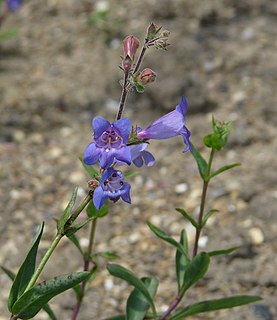
Penstemon roezlii is a species of penstemon known by the common name Roezl's penstemon. It is native to Oregon, western Nevada, and adjacent sections of northern California, including the Klamath Mountains and Sierra Nevada, where it grows in sagebrush and forest habitat types. It is a hairy, erect perennial herb growing to a maximum height of 55 centimeters from a woody, branching base. The leaves are up to 7 centimeters long, linear to widely lance-shaped and often folded lengthwise. The glandular inflorescence bears wide-mouthed tubular flowers up to 2.2 centimeters long in shades of blue-purple. The flowers are mostly hairless except for thin glandular hairs on the outer surfaces.
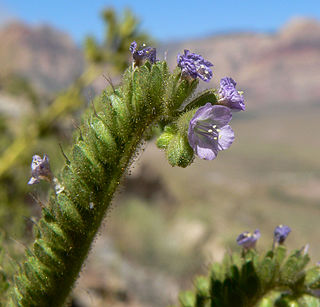
Phacelia anelsonii is a species of phacelia known by the common name Aven Nelson's phacelia. It is native to the Southwestern United States, where it is known from scattered occurrences in southwestern Utah, southern Nevada, and eastern California. It can be found in scrub and woodland habitat. It is named after the botanist Aven Nelson.
Phacelia austromontana is a species of phacelia known by the common name Southern Sierra phacelia. It is native to the southwestern United States, where it can be found in the Transverse Ranges and Sierra Nevada of California east to Utah. It grows in open mountainous habitat.
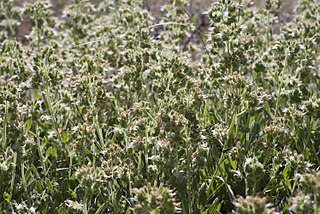
Phacelia corymbosa is a species of flowering plant known by the common name serpentine phacelia. It is native to the mountains of southern Oregon and northern California, where it grows in serpentine soils.
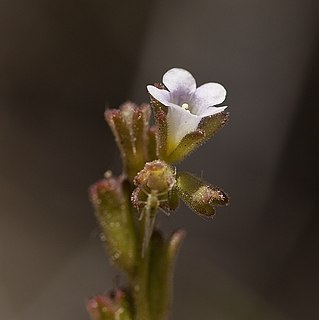
Phacelia lemmonii is a species of phacelia known by the common name Lemmon's phacelia. It is native to the southwestern United States, where it grows in mountain and sandy desert habitat.

Phacelia monoensis is an uncommon species of phacelia known by the common name Mono County phacelia.

Phacelia neglecta is a species of flowering plant in the borage family, Boraginaceae. Its common names include alkali phacelia and neglected scorpionweed. It is native to the deserts of the southwestern United States in Nevada, Arizona, and southeastern California, where it grows in varied desert habitat, including areas with alkali soils. It is likely that its distribution extends into Baja California.
Phacelia orogenes is an uncommon species of phacelia known by the common name mountain phacelia. It is endemic to California, where it is known only from the southern High Sierra, particularly around Mineral King in Sequoia National Forest.
Rosa bridgesii is a species of rose known by the common names pygmy rose and Sierran dwarf rose. It is native to California, where it grows in the forests of the Sierra Nevada and surrounding mountains and foothills. It may also occur in Oregon.

Rosa spithamea is a species of rose known by the common names ground rose and coast ground rose. It is native to Oregon and California, where it grows in forest and chaparral habitats, especially areas recently burned.
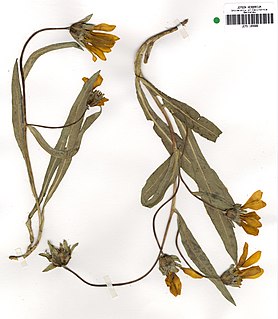
Wyethia longicaulis is a species of flowering plant in the aster family known by the common name Humboldt mule's ears. It is endemic to California, where it occurs in the North Coast Ranges and the Klamath Mountains. It grows in mountain and foothill habitat such as grassland and forests. It is a perennial herb growing from a tough taproot and caudex unit and producing a stem up to half a meter tall. It is hairless to hairy and glandular. The leaves have lance-shaped or oblong blades up to 20 centimeters long. They are glandular and have a waxy exudate that dries white. The inflorescence is usually a cluster of 2 to 4 flower heads, each with up to 10 yellow ray florets which may be up to 3 centimeters long. The fruit is an achene about a centimeter long, including its tiny pappus.
Agnorhiza ovata is a species of flowering plant known by the common name southern mule's ears. It is native to the mountains and foothills of southern California and Baja California, occurring the Coast Ranges and Sierra Nevada foothills in Tulare, Kern, Ventura, Los Angeles, Orange, Riverside, and San Diego counties in California, with additional populations in the Peninsular Ranges south of the international border.














